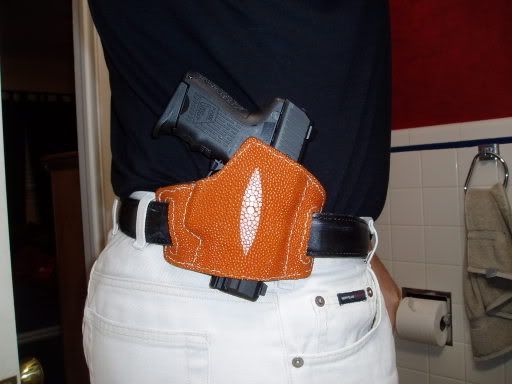Carrying OWB means that you will wear a shirt untucked or some kind of over-garment to cover it. If you're wearing OWB and trying to conceal with just a shirt there are some simple rules to use;
If you're using a light jacket or windbreaker to conceal, remember that the wind is usually more of a problem here because jackets are often not zipped up and more prone to catching the wind. Carry your car keys, pager or checkbook in the strong side jacket pocket for the extra weight.
While on that subject, for most light cover garments, you'll find it easier to draw if you add the weight of a pager or keys to the strong side pocket. When you sweep the jacket back during the draw, the momentum of the weighted pocket helps clear the holster, even in a pretty good wind. Try it with and without and you'll see. If you can try it in gusty wind that's hitting you at about a 4 o'clock to 6 o'clock angle it'll really prove the point.
The two most important parts of CCW are a quality belt and a quality holster. The belt must be stiff in it's vertical orientation so that it does not allow the holster to "lean out" away from the body, especially with a hi-cap magazine in the grip. If you can bend the top & bottom edges of the belt between thumb & forefinger, it's not stiff enough. A quality holster that keeps the butt snug against your side, with belt slots properly sized to your belt and can contour to the shape of your body is best.
- Shirts should have non-geometric patterns (this is why Hawaiian shirts work so well). This will help break up the outline of a gun if it begins to print.
- Buy a size larger than you'd normally wear tucked in. Some shirts come with a squared bottom in "long" sizes and those often work for folks with long torsos or those carrying a 4" barrel.
- If the shirt blows up in the breeze, visit a sewing store that carries fabrics, buttons, etc. You can sometimes get weighted "stays" that can be sewn into the shirt's hem on the gun side to add just enough weight to reduce that Marilyn Monroe wind-up-your-skirt feeling.

If you're using a light jacket or windbreaker to conceal, remember that the wind is usually more of a problem here because jackets are often not zipped up and more prone to catching the wind. Carry your car keys, pager or checkbook in the strong side jacket pocket for the extra weight.
While on that subject, for most light cover garments, you'll find it easier to draw if you add the weight of a pager or keys to the strong side pocket. When you sweep the jacket back during the draw, the momentum of the weighted pocket helps clear the holster, even in a pretty good wind. Try it with and without and you'll see. If you can try it in gusty wind that's hitting you at about a 4 o'clock to 6 o'clock angle it'll really prove the point.
The two most important parts of CCW are a quality belt and a quality holster. The belt must be stiff in it's vertical orientation so that it does not allow the holster to "lean out" away from the body, especially with a hi-cap magazine in the grip. If you can bend the top & bottom edges of the belt between thumb & forefinger, it's not stiff enough. A quality holster that keeps the butt snug against your side, with belt slots properly sized to your belt and can contour to the shape of your body is best.


